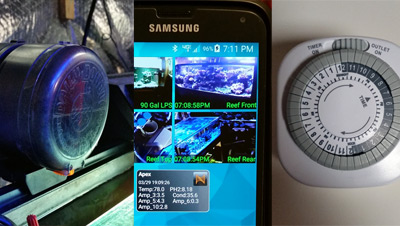In Part 1 of this series, I laid down some of the expectations for success, and now we are ready to dive into the functions that we can automate. Automation can range from low-tech to high-tech and fit various budgets, though the level of refinement of the solution and its robustness can be a function of cost and knowledge. As long as the solution serves the purpose you need it to perform, then it is a viable solution.
Stages of automation based on budget or need
This is a major part of the planning phase since you need to understand what is available to you and for what cost. Fortunately these can be implemented as needed or as funds become available since very few people can afford all this at once. We will focus on the practical levels of automation, but if you have the money and the knowledge, you can reach very extreme levels of automation. So below are some ideas of what to automate and their options. This is by no means an exhaustive list but something to act as a guide to what’s possible.
If you are “do-it-yourself” type of person, then many more options are available to you as long as you understand the principles of what you are trying to achieve. If not, then stick with off-the-shelf solutions. In the end, it may be a wash with respect to cost since DIY folks will have to purchase tools and materials in addition to having the proper skills to produce the same product.
Feeding:
- Simple/cheap: food blocks and battery-operated feeders, DIY “mush.”
- Complex/costly: controller-linked feeder, refrigerated auto dosing of fluidized foods.
Salt water mixing:
- Simple/cheap: manually mix with a powerhead as needed with distilled fresh water in five-gallon buckets.
- Complex/costly: semi-automated RO/DI unit with float valves into storage/mixing tanks to 100% automated mixing stations.
Filtration:
- Simple/cheap: Rubbermaid tote sumps, filter sock, foam filters, refugia, all-in-one systems, hang-on-back power filters or canister filters, lanthanum chloride.
- Complex/costly: skimmers, professional sumps, various reactors (granular ferric oxide, granular activated carbon, biopellets, ZEOvit ZEOlite), UV sterilizers, ozone generators.
Evaporation control:
- Simple/cheap: gravity-fed or RO/DI plumbed to a float valve.
- Complex/costly: sensor/pump-driven auto top-offs.
Water changing:
- Simple/cheap: Python hose attachment to your sink (still beats carrying buckets) or even a gravity-fed saltwater drip system that overflows into a drain pipe.
- Complex/costly: controller-based system plumbed to a salt water mixing station with feedback from various float switches in the sump and a passive overflow to a drain.
Water chemistry:
- Simple/cheap: manual water changes, Kalkwasser or Mrs. Wages Pickling Lime, Arm & Hammer baking soda (alk), pure calcium chloride ice melt (Ca), Epsom salt (Mg).
- Complex/costly: carbon dosing (vodka, vinegar, biopellets), pharmaceutical-grade calcium, alkalinity and magnesium dosing, calcium reactors, potassium iodide, strontium, and various additives for trace elements.
Controllers:
- Simple/cheap: outlet timers or relays, personal-computer-based.
- Complex/costly: Raspberry Pi, hobby-grade controller solutions, industrial-grade controllers.
Presence:
- Simple/cheap: asking someone to come over aided by using a webcam on a PC with you on the other end.
- Complex/costly: IP webcams (Mpeg, HD).
Ventilation control:
- Simple/cheap: open the windows often, run an air hose from skimmer venturi intake to the outside.
- Complex/costly: insert ducted fans to drive stale, moist air out and fresh air in via CO2 monitor.
Backup power:
- Simple/cheap: battery packs, PC UPS, portable generator with gas/propane/natural gas option kit.
- Complex/costly: whole-house auto-switching generator.
Glass cleaning:
- Simple/cheap: good ol’ elbow grease using algae scraper, magnet scrapers, and/or Mr. Clean Magic Eraser pads.
- Complex/costly: products such as the AquaGenesis RoboSnail, which clean only a single pane of glass, to something extreme like the Ocean Swipe 360 Jr., which can clean and polish up to four viewing panes of the tank.
Summary of Part 2
Keep in mind that in any hobby, you can invest as much or as little as you wish based on the outcome you want to achieve. This list is a start for planning and research of the best practices and designs/products. There’s a wealth of knowledge and experience on the internet today that can help beginners succeed on the first try if they do their homework.
The nice thing is that many simple options can be added on as you see fit. But at some point, once you cross the threshold into the realm of aqua controllers, you’ll discover many more options and capabilities than just functionality.
In Part 3 of this series, I will discuss what I consider to be the minimal automation for most people to get by on weekends and possibly a week away—small investments that will allow you to enjoy your time away. So stay tuned!
Read the other installments in this series:



